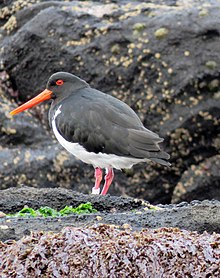Chatham oystercatcher
The Chatham oystercatcher or Chatham Island oystercatcher (Haematopus chathamensis) is a bird in the family Haematopodidae. It lives in only on New Zealand's Chatham Islands.[2]
| Chatham oystercatcher | |
|---|---|

| |
| Scientific classification | |
| Domain: | Eukaryota |
| Kingdom: | Animalia |
| Phylum: | Chordata |
| Class: | Aves |
| Order: | Charadriiformes |
| Family: | Haematopodidae |
| Genus: | Haematopus |
| Species: | H. chathamensis
|
| Binomial name | |
| Haematopus chathamensis (Hartert, 1927)
| |
Appearance
changeIts body is smaller and thicker than the variable oystercatcher's, but they both have black and white feathers.
Habitat and actions
changeChatham oystercatchers live in pairs. These pairs will fight other Chatham oystercatchers over good places to look for food and build nests. This bird builds nests on rocky coasts. It likes sheltered coasts the most.[2]
The male and female bird both sit on the eggs. There are 1-3 eggs at a time. Male and female oystercatchers usually stay partners their whole lives, but sometimes they do not.[2]
Food
changeChatham oystercatchers use their beaks to dig in the sand for amphipods, polychaete worms, ribbon worms, molluscs, crustaceans, echinoderms, ascidians, and anemones.[2]
Threats
changeIn the 1970s there were as few as 50 Chatham oystercatchers alive on Chatham Island (and others on other nearby islands). By 1998, there were about 140. Conservationists tried even harder to save the birds. There were 300 Chatham oystercatchers alive by 2005.[2]
This bird is threatened because human beings change the places it lives. Human beings changed the islands to make farmland, and they put marram grass on the sand dunes, which changes the way the sand flows. The dunes are steeper, so the birds must build nests closer to the water, and sometimes the high tide takes the eggs away. Humans also brought new animals to the islands in the 1800s: cats eat eggs and chicks, and weka eat eggs.[2]
References
change- ↑ BirdLife International. "Chatham Oystercatcher: Haematopus chathamensis". IUCN Red List of Threatened Species. 2017. The IUCN Red List of Threatened Species: e.T22693656A118496303. doi:10.2305/IUCN.UK.2017-3.RLTS.T22693656A118496303.en. Retrieved August 30, 2021.{{cite iucn}}: error: |page= / |url= mismatch (help)
- ↑ 2.0 2.1 2.2 2.3 2.4 2.5 "Chatham Island oystercatcher: Haematopus chathamensis Hartert, 1927". New Zealand Birds. Retrieved August 30, 2021.
